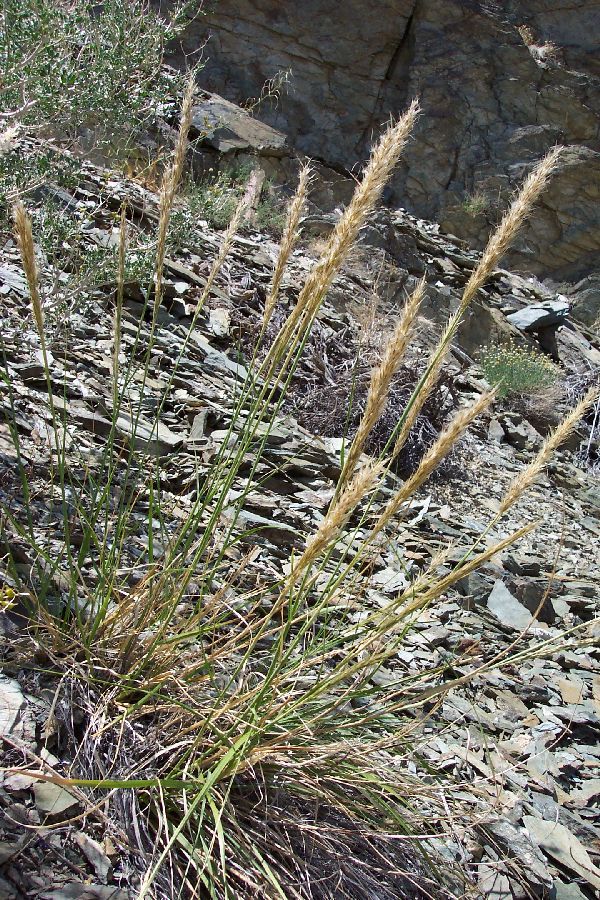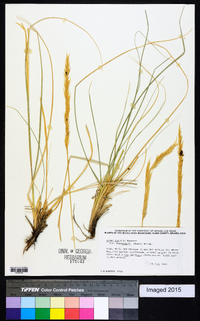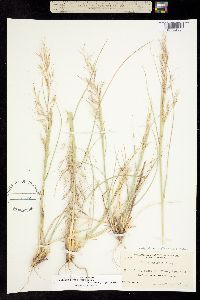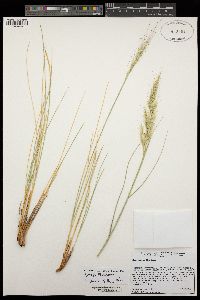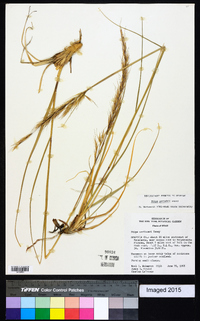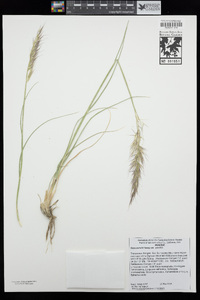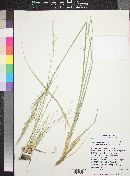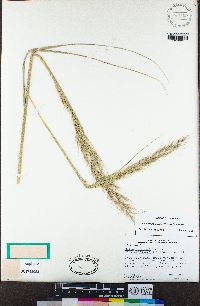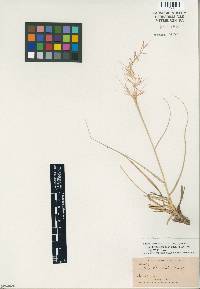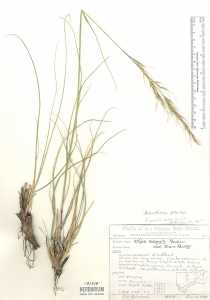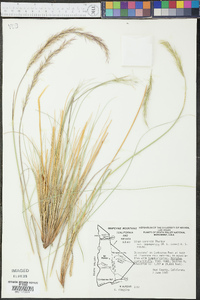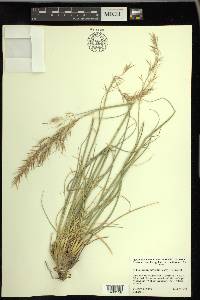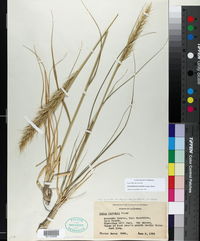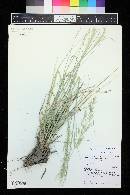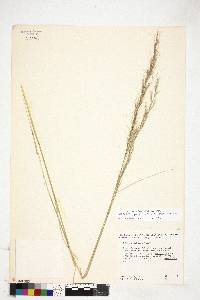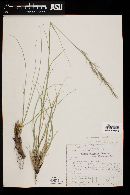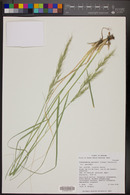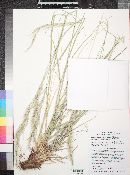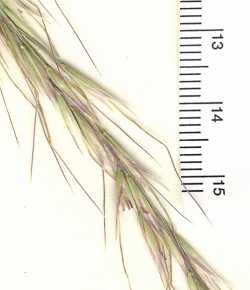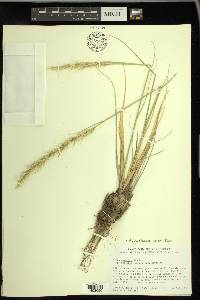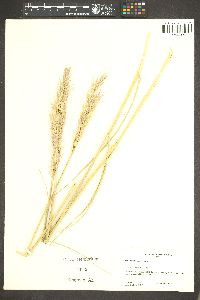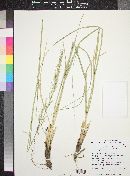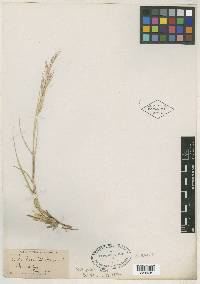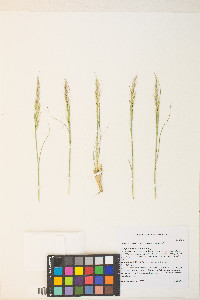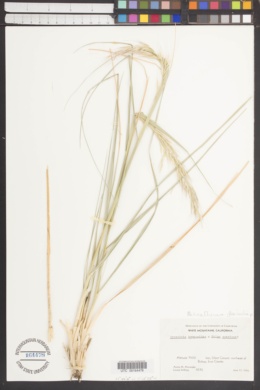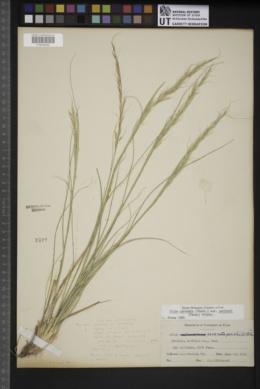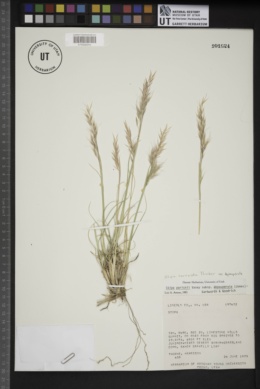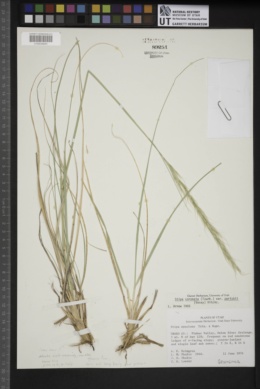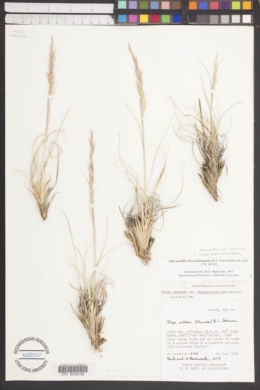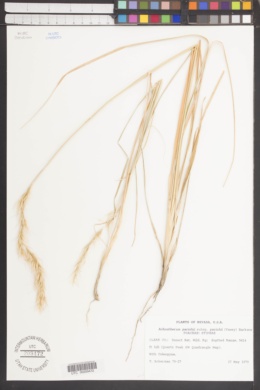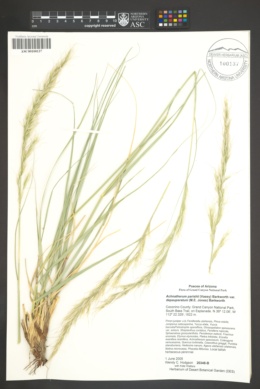
|
|
|
|
Family: Poaceae
Parish's needlegrass, more...Parish's Rice Grass, Parish achnatherum
[Stipa coronata subsp. parishii (Vasey) Hitchc.] |
Plants tightly cespitose, not rhizomatous. Culms 14-80 cm tall, 0.8-2 mm thick, internodes glabrous or pubescent below the nodes; nodes 3-5, glabrous. Basal sheaths mostly glabrous, sometimes pubescent at the base, flat and ribbonlike with age, margins sometimes hairy distally, hairs adjacent to the ligules 0.5-3 mm; collars glabrous; ligules truncate, abaxial surfaces pubescent, ciliate, cilia as long as or longer than the basal membrane, ligules of basal leaves 0.3-0.8 mm, of upper leaves 0.5-1.5 mm, asymmetric; blades 4-30+ cm long, 1-4.2 mm wide, usually flat and more or less straight, sometimes tightly convolute and arcuate. Panicles 7-15 cm long, 1.5-4 cm wide; branches strongly ascending at maturity, longest branches 1.5-4 cm. Glumes unequal to subequal, narrowly lanceolate, 3-5-veined; lower glumes 9-15 mm long, 0.9-1.2 mm wide; upper glumes 8-15 mm; florets 4.8-6.5 mm long, 0.8-1 mm thick, fusiform, terete; calluses 0.2-0.8 mm, acute; lemmas evenly and densely hairy, hairs 1.5-3.5 mm at midlength, apical hairs 2.5-5 mm; awns 10-35 mm, persistent, once-geniculate, first segment scabrous or strigose, hairs to 0.3 mm, terminal segment straight; paleas 2.5-4.5 mm, 1/2-4/5 times the length of the lemmas, hairy between the veins, hairs often as long as those on the lemmas but not as dense, apices usually rounded, occasionally somewhat pinched; anthers 2.3-4.5 mm, dehiscent, not penicillate. Caryopses 3-6 mm, fusiform. 2n = unknown. Achnatherum parishii grows from the coastal ranges of California to Nevada and Utah, south to Baja California, Mexico, and to the Grand Canyon in Arizona. It differs from A. coronatum in its once-geniculate awns, more densely pubescent paleas, and generally smaller stature; from A. scribneri in its shorter, blunter calluses and more abundant lemma hairs; and from A. perplexum in having longer hairs on its lemmas. Dr. David Bogler, USDA NRCS PLANTS Database Perennials, Terrestrial, not aquatic, Stems nodes swollen or brittle, Stems erect or ascending, Stems caespitose, tufted, or clustered, Stems terete, round in cross section, or polygonal, Stem internodes hollow, Stems with inflorescence less than 1 m tall, Stems with inflorescence 1-2 m tall, Stems, culms, or scapes exceeding basal leaves, Leaves mostly basal, below middle of stem, Leaves mostly cauline, Leaves conspicuously 2-ranked, distichous, Leaves sheathing at base, Leaf sheath mostly open, or loose, Leaf sheath smooth, glabrous, Leaf sheath hairy at summit, throat, or collar, Leaf sheath and blade differentiated, Leaf blades linear, Leaf blades very narrow or filiform, less than 2 mm wide, Leaf blades 2-10 mm wide, Leaf blades mostly flat, Leaf blade margins folded, involute, or conduplicate, Leaf blades mostly glabrous, Leaf blades more or less hairy, Ligule present, Ligule an unfringed eciliate membrane, Inflorescence terminal, Inflorescence a contracted panicle, narrowly paniculate, branches appressed or ascending, Inflorescence solitary, with 1 spike, fascicle, glomerule, head, or cluster per stem or culm, Flowers bisexual, Spikelets pedicellate, Spikelets dorsally compressed or terete, Spikelet less than 3 mm wide, Spikelets with 1 fertile floret, Spikelets solitary at rachis nodes, Spikelets all alike and fertille, Spikelets bisexual, Spikelets disarticulating above the glumes, glumes persistent, Spikelets disarticulating beneath or between the florets, Rachilla or pedicel glabrous, Glumes present, empty bracts, Glumes 2 clearly present, Glumes equal or subequal, Glumes equal to or longer than adjacent lemma, Glumes 3 nerved, Lemma 5-7 nerved, Lemma body or surface hairy, Lemma apex acute or acuminate, Lemma distinctly awned, more than 2-3 mm, Lemma with 1 awn, Lemma awn 1-2 cm long, Lemma awn 2-4 cm long or longer, Lemma awned from tip, Lemma awn twisted, spirally coiled at base, like a corkscrew, Lemma awn once geniculate, bent once, Lemma margins inrolled, tightly cove ring palea and caryopsis, Lemma straight, Callus or base of lemma evidently hairy, Callus hairs shorter than lemma, Lemma surface pilose, setose or bristly, Palea present, well developed, Palea membranous, hyaline, Palea shorter than lemma, Stamens 3, Styles 2-fid, deeply 2-branched, Stigmas 2, Fruit - caryopsis, Caryopsis ellipsoid, longitudinally grooved, hilum long-linear.
|

